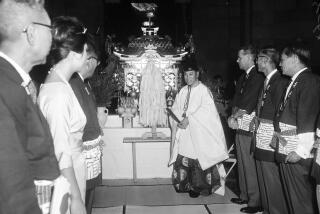Turning Back the Clock at City Hall : Burbank: A party spotlights the many roles--both civic and cinematic--played by the 50-year-old structure.
- Share via
As the strains of Duke Ellington’s “Satin Doll” floated through the crowded lobby of Burbank City Hall on Friday, the year for a moment was 1943.
The jitterbug. Big Bands. Duke Ellington. World War II.
That year, the construction of Burbank City Hall was completed under the supervision of then-City Manager Howard Stites, and the building quickly became the heart of the city. It contained the city’s jail, an emergency hospital, the courtroom, the mayor’s office, the Police Department. City Hall was a place where people came to have needs met and questions answered.
Fifty years later, Burbank has grown and many of the services once offered at City Hall have branched out into other buildings. But City Hall remains central to the functioning of the city and it symbolizes an integral part of Burbank’s history.
“The building is more than just our City Hall,” Mayor Robert R. Bowne said Friday at a celebration of the building’s 50th anniversary. “It’s the very heart of our community.” Bowne was among the more than 100 people who attended the celebration. Visitors listened to speeches on the history of City Hall, heard city leaders reflect on the city’s past and took tours of the building.
Teacher Linda Walmsley brought her class of first-grade students from Joaquin Miller Elementary School to teach them a lesson in social studies and civic pride.
“I firmly believe we need to establish in our kids a sense of community,” she said, as her students sat attentively in front of City Hall.
And for Helen and Cliff Lott, who recently moved to Burbank from Monrovia, the ceremony was an opportunity to learn about the history of their adopted city.
“It seems like such a wonderful, community-spirited city and we wanted to participate,” Helen Lott said.
Among those who also attended the ceremony was Stites, now 92. Surrounded by city officials and well-wishers who credited him for the enduring aesthetic and functional features of the building, Stites reflected on his days in City Hall.
“The city manager didn’t build this building,” Stites said. “The people did. We dug the sand and the rock and gravel from our own quarry, from the bottom up. It was built by the people of Burbank.”
Back then, Stites served as many functions as the building itself. In addition to being the city manager from 1943 to 1952, he was also the public works director and the city engineer.
And like many in the city, he raised his three children to have a strong sense of civic pride and involvement.
His daughter, Shirley Arnold, was about 6 years old when City Hall was built.
“It has a lot of marvelous memories in it,” Arnold said, standing in the building’s lobby Friday. “The whole city does, but City Hall especially. It’s still a great building.”
Apparently many film producers agree. The building is often used in films and television movies.
Mary Jane Strickland, who worked for the city for 28 years and is the founder of the Burbank Historical Society, remembers the many actors and actresses who have trekked through Burbank City Hall.
“Almost every week there was something,” said Strickland, who served as a docent Friday. “We used to do a lot of James Garner’s “The Rockford Files,” she said. “Patty Duke fell asleep in a sleeping bag right outside that door. Jane Wyman was here once.”
And just last week the building was used in a movie called “A Place To Be.”
Although much has obviously changed in Burbank over 50 years, for Stites, who now lives in Sacramento, much in the city remains the same.
“The most noticeable thing is that it hasn’t changed,” Stites said. “The people are still the greatest. That’s what I like about it.
“I went out and saw the house I used to live in and the old golf course. Everything is just the same.”
In addition to the rare marble, wood, and ornate decorations throughout City Hall, there are two murals by Hugo Ballin, “Burbank Industry” and “The Four Freedoms.”
Now that City Hall has passed the 50-year mark, it is eligible to be included on the National Register of Historic Places, and members of the Burbank Historical Society plan to make sure it makes the list, said Gary Sutliff, a member of the society.
More to Read
Sign up for Essential California
The most important California stories and recommendations in your inbox every morning.
You may occasionally receive promotional content from the Los Angeles Times.









